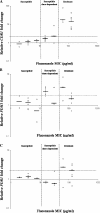Antifungal resistance of Candida glabrata vaginal isolates and development of a quantitative reverse transcription-PCR-based azole susceptibility assay
- PMID: 18591262
- PMCID: PMC2533493
- DOI: 10.1128/AAC.00462-08
Antifungal resistance of Candida glabrata vaginal isolates and development of a quantitative reverse transcription-PCR-based azole susceptibility assay
Abstract
A multiplex quantitative reverse transcription-PCR assay was developed to detect azole resistance in Candida glabrata, an important opportunistic pathogen that develops resistance rapidly. Resistance was defined as a >or=3-fold increase in CDR1 expression by this assay, which proved to be 100% sensitive and 95% specific in comparison to the gold standard broth microdilution assay.
Figures

Similar articles
-
Activity of Isavuconazole and Other Azoles against Candida Clinical Isolates and Yeast Model Systems with Known Azole Resistance Mechanisms.Antimicrob Agents Chemother. 2015 Oct 19;60(1):229-38. doi: 10.1128/AAC.02157-15. Print 2016 Jan. Antimicrob Agents Chemother. 2015. PMID: 26482310 Free PMC article.
-
A Combination Fluorescence Assay Demonstrates Increased Efflux Pump Activity as a Resistance Mechanism in Azole-Resistant Vaginal Candida albicans Isolates.Antimicrob Agents Chemother. 2016 Sep 23;60(10):5858-66. doi: 10.1128/AAC.01252-16. Print 2016 Oct. Antimicrob Agents Chemother. 2016. PMID: 27431223 Free PMC article.
-
Mechanisms of azole resistance in clinical isolates of Candida glabrata collected during a hospital survey of antifungal resistance.Antimicrob Agents Chemother. 2005 Feb;49(2):668-79. doi: 10.1128/AAC.49.2.668-679.2005. Antimicrob Agents Chemother. 2005. PMID: 15673750 Free PMC article.
-
Antifungal drug resistance: mechanisms, epidemiology, and consequences for treatment.Am J Med. 2012 Jan;125(1 Suppl):S3-13. doi: 10.1016/j.amjmed.2011.11.001. Am J Med. 2012. PMID: 22196207 Review.
-
Antifungal drug resistance in Candida glabrata: role of cellular signaling and gene regulatory networks.FEMS Yeast Res. 2025 Jan 30;25:foaf025. doi: 10.1093/femsyr/foaf025. FEMS Yeast Res. 2025. PMID: 40378148 Free PMC article. Review.
Cited by
-
Antifungal drug resistance: do molecular methods provide a way forward?Curr Opin Infect Dis. 2009 Dec;22(6):568-73. doi: 10.1097/QCO.0b013e3283321ce5. Curr Opin Infect Dis. 2009. PMID: 19741524 Free PMC article. Review.
-
Gain of function mutations in CgPDR1 of Candida glabrata not only mediate antifungal resistance but also enhance virulence.PLoS Pathog. 2009 Jan;5(1):e1000268. doi: 10.1371/journal.ppat.1000268. Epub 2009 Jan 16. PLoS Pathog. 2009. PMID: 19148266 Free PMC article.
-
Vulvovaginal candidiasis and current perspectives: new risk factors and laboratory diagnosis by using MALDI TOF for identifying species in primary infection and recurrence.Eur J Clin Microbiol Infect Dis. 2021 Aug;40(8):1681-1693. doi: 10.1007/s10096-021-04199-1. Epub 2021 Mar 13. Eur J Clin Microbiol Infect Dis. 2021. PMID: 33713006 Free PMC article.
-
Relative Contribution of the ABC Transporters Cdr1, Pdh1, and Snq2 to Azole Resistance in Candida glabrata.Antimicrob Agents Chemother. 2018 Sep 24;62(10):e01070-18. doi: 10.1128/AAC.01070-18. Print 2018 Oct. Antimicrob Agents Chemother. 2018. PMID: 30038038 Free PMC article.
-
Can We Improve Antifungal Susceptibility Testing?Front Cell Infect Microbiol. 2021 Sep 10;11:720609. doi: 10.3389/fcimb.2021.720609. eCollection 2021. Front Cell Infect Microbiol. 2021. PMID: 34568095 Free PMC article. Review.
References
-
- Bader, M. S., S. M. Lai, V. Kumar, and D. Hinthorn. 2004. Candidemia in patients with diabetes mellitus: epidemiology and predictors of mortality. Scand. J. Infect. Dis. 36:860-864. - PubMed
-
- Banerjee, S. N., T. G. Emori, D. H. Culver, R. P. Gaynes, W. R. Jarvis, T. Horan, J. R. Edwards, J. Tolson, T. Henderson, and W. J. Martone. 1991. Secular trends in nosocomial primary bloodstream infections in the United States, 1980-1989. National Nosocomial Infections Surveillance System. Am. J. Med. 16:86S-89S. - PubMed
-
- Dan, M., R. Segal, V. Marder, and A. Leibovitz. 2006. Candida colonization of the vagina in elderly residents of a long-term-care hospital. Eur. J. Clin. Microbiol. Infect. Dis. 25:394-396. - PubMed
-
- Goswami, D., R. Goswami, U. Banerjee, V. Dadhwal, S. Miglani, A. A. Lattif, and N. Kochupillai. 2006. Pattern of Candida species isolated from patients with diabetes mellitus and vulvovaginal candidiasis and their response to single dose oral fluconazole. J. Infect. 52:111-117. - PubMed
Publication types
MeSH terms
Substances
LinkOut - more resources
Full Text Sources

